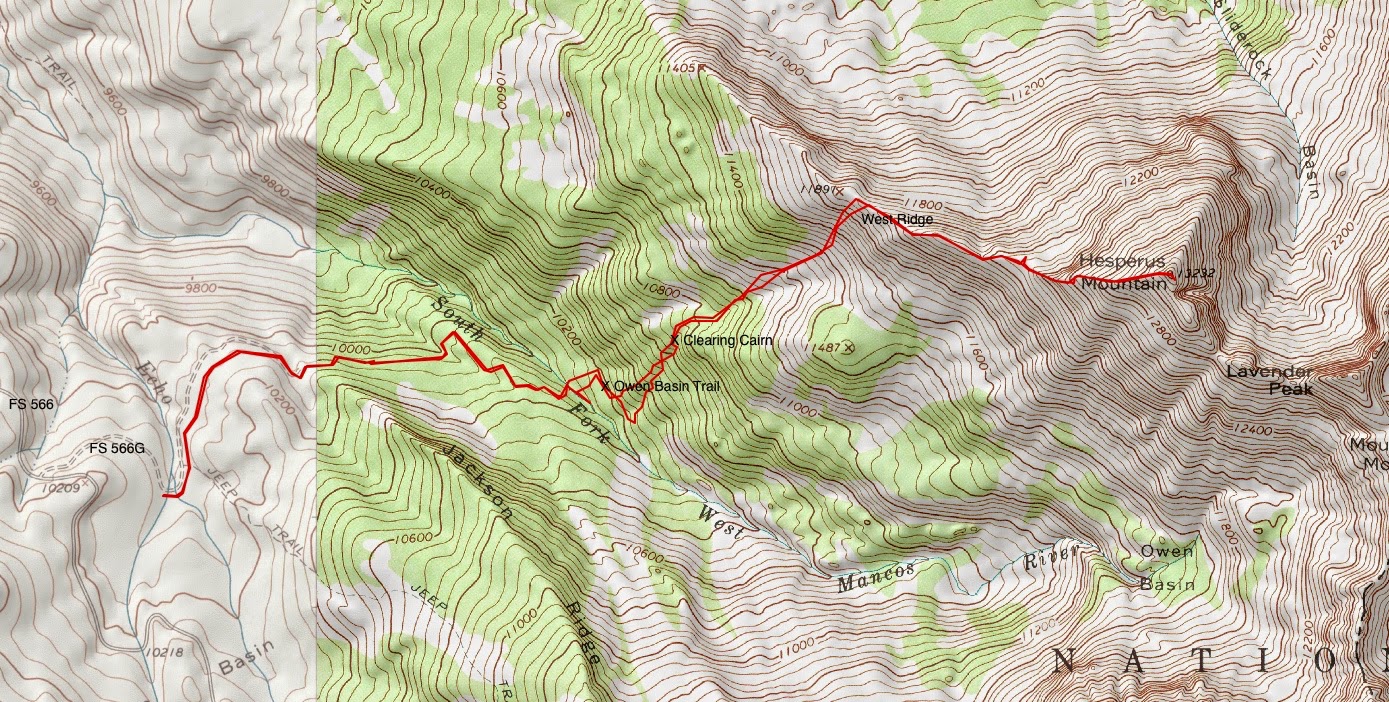Travel: From the US 160/550 intersection in Durango, travel 11.0 miles west on US 160 to Hesperus. Turn right/north on La Plata Canyon Road, CR 124. Zero-out your trip meter. There is a brown, US Forest Service sign with mileages right after the turn. After passing the hamlet of Mayday, the road turns to smooth dirt at 4.6 miles. There are several established campgrounds in this area. In 8.5 miles the roadbed deteriorates with sharp, sizable rocks. At 12.1 miles the road splits; take the left track, FS 571. High clearance, 4WD is recommended from here. It is 14.2 miles to the Kennebec Pass Trailhead from US 160. Allow 1:00 to 1:30 from Durango.
Distance and Elevation Gain: 12.5 miles, 2,620 feet of climbing includes the Boulder Ridge loop
Time: 6:30 to 7:30
Difficulty: Groomed Colorado trail; navigation easy; no exposure; optional off-trail loop has two boulder fields
Maps: La Plata, Colorado 7.5 Quad, or Trails Illustrated No. 144, Durango-Cortez
Latest Date Hiked: July 13, 2024
Quote: Eastward the dawn rose, ridge behind ridge into the morning, and vanished out of eyesight into guess; it was no more than a glimmer blending with the hem of the sky, but it spoke to them, out of the memory and old tales, of the high and distant mountains. J.R.R. Tolkien, The Lord of The Rings
Sky-high Point 12,181' is one of five numbered points between the Kennebec Pass Trailhead and the Grindstone Trail.
Route: A tangle of 4WD roads and trails pin-wheel off from the Kennebec Pass Trailhead at elevation 11,600 feet. Take a moment to be certain you are heading west on the Colorado Trail toward Taylor Lake. The lake, a popular destination, is a relatively flat 1.2 miles away on a groomed expressway of a trail.
Skirt the north side of the lake and begin a 0.6 mile, easy 520 foot climb up to the ridge. The lake recedes while the east block of the La Platas rises to steal the show.
It is simply done and a great pleasure to leave the trail briefly to experience the high points. The 2,620 feet of elevation gain reflects touching the ridge crests while traveling north, and staying on the trail for the return. Below, hikers cross a neck on their way to Peak 12,338', the loftiest rise of the day. (LiDAR has increased the elevation to Peak 12,342' with a rise of 411 feet.)
From Peak 12,338', the view from solitary Lone Cone to the Lizard Head spire is a small slice of the horizon's unfettered circle.
The ridge affords a unique perspective on the west massif of the La Plata Mountains. The arc swings from Diorite to Sharkstooth Peak. Banded Hesperus Mountain, 13,238', is the tallest eminence in the range.
Hikers climb the rocky ridge south of Point 12,181'. Miles slide by in such a hurry on the immaculate Colorado Trail.
The ridge is studded with stone boys, but even without them it would be impossible to get lost on the restricted divide, even if the trail was obliterated by snow.
The flora on this hike was so rich, a friend exclaimed, "Ninety percent of Colorado's wildflower inventory is in bloom." Point 12,078' is where Old Man Of The Mountain lives in absurdly opulent conditions. He keeps house with aromatic phlox; tasty geyer onion and mountain parsley; his feminine companion, rosy paintbrush; and chiming bluebells. Osho must have been standing right here when he wrote, It is simply unbelievable how happy flowers are.
It is just shy of 5.7 miles to the Grindstone Trail. While our hike turns around here, there are options. The Colorado Trail continues north and just keeps on going all the way to Denver. For the Highline Loop, take the Grindstone west to abut the Bear Creek Trail in 4 miles. Turn south to reach the Sharkstooth Trail in another 5.75 miles. Go east on that trail for 3.3 miles back to Taylor Lake. Turn right and walk the 1.2 miles back to Kennebec Pass. That's adding up to more like 21 miles, not a mere 17 as the sign at the lake indicates. The Highline Loop was designated a National Recreation Trail in 1979 because of its extraordinary scenic value.
The Return:
From the ridge, Engineer Mountain dominates the San Juan earthline across the Hermosa Creek rift.
On a portion of the ridge, horizontal slabs of stone are strewn about. Linger amongst a stretch of rocks scattered carelessly like piles of books. The floral arrangement in early summer is arnica mollis.
To be a La Plata devotee, cypher and memorize the names of the mountains marching through the view finder.
Cross a swath of boulders and then climb gently for 170 feet to the final roll of the ridge at 12,250 feet. Pass two towers topping the point. Where the ridge splits, descend the southeast rib.
Enormous boulders teeter totter under foot.
In 2014, I walked ITR with a sizable group of friends and we frightened off the fauna. On a solitary trek I witnessed ravens, swallows at speed, tiny tweety birds foraging on snow patches, a curious ermine, marmots, mountain lion tracks in the muddy trail, deer, and large herds of elk in both the Hermosa Creek and Bear Creek drainages.































































